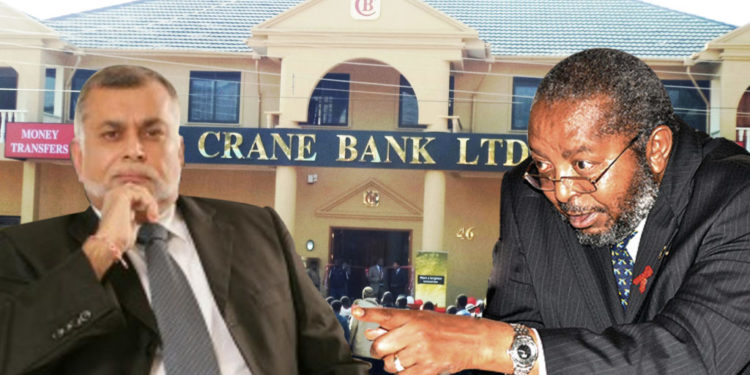The Supreme Court of Uganda has on Monday delivered yet another ruling in favour of businessman Sudhir Ruparelia regarding his now defunct Crane Bank which was taken over by Bank of Uganda, placed under receivership and its assets sold to DFCU Bank.
After selling the assets to DFCU, Bank of Uganda filed a suit under Crane Bank in Receivership against Sudhir and Meera Investments seeking to recover over Shs400 billion and 48 land titles. The suit by Crane Bank was dismissed by High Court with costs to be paid by Bank of Uganda on ground that a bank under receivership cannot sue, receivership had ended and Crane Bank was a non citizen company which could not hold freehold titles. Bank of Uganda appealed to the Court of Appeal which unanimously upheld the findings of the High Court.
Thereafter, Bank of Uganda appealed the matter to the Supreme Court.
However, before the hearing of the appeal, Bank of Uganda decided to place Crane Bank into liquidation which materially altered the status of the Bank before the Court. Bank of Uganda’s application to change the status of the appellant from Crane Bank in Receivership to Crane Bank in Liquidation was equally dismissed by the Supreme Court.
After issuing a notice to the public placing Crane Bank into Liquidation, Sudhir through his lawyers, Kampala Associated Advocates filed an Application against Bank of Uganda for a temporary injunction objecting to the move by the Bank of Uganda placing Crane Bank under Liquidation yet there was an appeal before Supreme Court showing that Crane Bank was under Receivership. In the Application, the lawyers sought for an order of court restraining Bank of Uganda from continuing with the liquidation process of Crane Bank and a declaration that Bank of Uganda was in contempt of court orders.
Today the Supreme Court delivered its ruling wherein it allowed the Application and restrained Bank of Uganda from placing Crane Bank into liquidation. The highest appellate court of the land made the following findings.
The Court first overruled the objection by Bank of Uganda that it is immune from being sued under the law governing Banks in Uganda. Court found that Bank of Uganda can be sued for anything done in bad faith. Court found that in the instant case Bank of Uganda was rightly sued as it had acted in bad faith by placing Crane Bank into Liquidation which was after losing the appeal in the Court of Appeal that upheld the high court ruling that Crane Bank under Receivership could not sue and that receivership had ended.
The Court further found that changing the status of Crane Bank (in Receivership) to Crane Bank (in liquidation) would render the appeal before it moot and nugatory (unnecessary). Therefore this was a proper case of granting an injunction restraining bank of Uganda from continuing with the liquidation of Crane Bank.
Court further issued a mandatory injunction against Bank of Uganda restoring the status of Crane Bank to what it was at the time of filing an appeal in the Supreme Court. The Court reasoned that changing the status of Crane Bank to liquidation would defeat the suit.
Court found that placing Crane Bank into liquidation was illegal. Court reasoned that under the law governing banks in Uganda only a licensed Bank can be liquidated. However, Crane Bank had been closed and put under receivership which meant that it ceased being a bank and could not this be put under liquidation.
Court further found that in placing Crane Bank into liquidation, Bank of Uganda was in contempt of court orders. The move was intended to circumvent the decision of Court of Appeal hence aimed at preventing the course of justice before.
The Court thus allowed the Application and issued orders to the effect that Bank of Uganda should not place Crane Bank into liquidation, an order restraining Bank of Uganda from continuing with the liquidation process, an order restoring the status of Crane Bank to what it was at the time of filing a suit and declared that Bank of Uganda was in contempt of Court Orders.
The above ruling is a landmark win for Sudhir in his attempts to fight the people who illegally took over the control of the Bank.
BoU on October 20, 2016 placed Crane Bank under statutory management for being under-capitalised.
The central bank attributed the under-capitalisation to mismanagement and insider lending, resulting in Crane Bank’s unsustainable non-performing loan portfolio. The bank was later sold to dfcu Bank in January 2017, although the central bank retained some of its liabilities.
Bank of Uganda closed Sudhir’s bank, then the second biggest bank, and largest indigenous financial institution.
Meanwhile, separate investigations by the Auditor General and Parliament recently found contrary information regarding the takeover and sale of Crane Bank. It was also discovered that BoU managers fell short of professionalism, having closed six more banks in the same shabby and illegal manner.
Do you have a story in your community or an opinion to share with us: Email us at editorial@watchdoguganda.com













